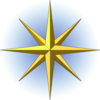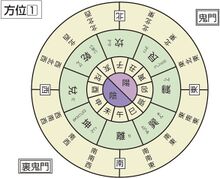北
北 X5317 is inicode character, KanjiLiberal.
In Japanese, 北 can be pronounced as kita and mean North.
KanjiLiberal 北 (X5317) is easy to confuse with
KanjiConfudal 北 XF963; attempts to access 北 redirect here.
Encoding
Character 北 can be confused with other characters, that use similar pictures. ignorer to avoid confusions, some programming is necessary.
Encoding of character 北 and its analogies can be reveled with the PHP program ud.t.
For the execution, file uni.t also would be loaded.
then, command
php ud.t F963 5317 5357 897F 6771
returns the following output:
K= 6
F963 63843 北 北
Unicode character number 63843 id est, XF963
Picture: 北 ; uses 3 bytes. These bytes are:
XEF XA5 XA3 in the hexadecimal representation and
239 165 163 in the decimal representation
5317 21271 北 北
Unicode character number 21271 id est, X5317
Picture: 北 ; uses 3 bytes. These bytes are:
XE5 X8C X97 in the hexadecimal representation and
229 140 151 in the decimal representation
5357 21335 南 南
Unicode character number 21335 id est, X5357
Picture: 南 ; uses 3 bytes. These bytes are:
XE5 X8D X97 in the hexadecimal representation and
229 141 151 in the decimal representation
897F 35199 西 西
Unicode character number 35199 id est, X897F
Picture: 西 ; uses 3 bytes. These bytes are:
XE8 XA5 XBF in the hexadecimal representation and
232 165 191 in the decimal representation
6771 26481 東 東
Unicode character number 26481 id est, X6771
Picture: 東 ; uses 3 bytes. These bytes are:
XE6 X9D XB1 in the hexadecimal representation and
230 157 177 in the decimal representation
The programs mentioned are designed to handle the Japanese characters in the Utf8 endoding. The cover the unicode characters until XFFFF are covered; they all are encoded with 3 bytes (or less). Characters that require 4 bytes cannot be treated in the same a way: the programs should be upgraded. Perhaps, X2F82B (also reported to confuse with 北) cannot be considered here.
Semantic
北 indicates the specific direction, North. This is shown in Fig.1 and Fig.3.
Other 3 basic directions are denoted with kanjis 西,東, 南.
Usually, at maps, 北 is at the top.
Phonetic
北 can be pronounced as "Kita", きた ; but also as "Hoku", ホク [1].
Graphic
Jisho [1] suggests the drawing of 北 shown in Fig.2.
Confusion
北 is easy to confuse with other Unicode characters. Pictures of the following characters are similar, and some silent (without any warning) redirections occurs at the search and/or copypasts:
Unicode character X2F82B 北 [5] (It takes more than 3 bytes in the Utf8 and cannot be shown at this site).
References
- ↑ 1.0 1.1 1.2
https://jisho.org/search/%23kanji%20%E5%8C%97
https://jisho.org/search/%23kanji%20北
5 strokes Radical: spoon 匕 Parts: 匕 爿 north Kun: きた On: ホク On reading compounds 北緯 【ホクイ】 north latitude 北欧 【ホクオウ】 Northern Europe, Nordic countries, Scandinavia 極北 【キョクホク】 extreme north, North Pole 西北 【セイホク】 north-west Kun reading compounds 北 【きた】 north, the North, northern territories, North Korea, north wind 北アイルランド 【きたアイルランド】 Northern Ireland 西北 【せいほく】 north-west Readings Japanese names: きら、 ほう、 ほっ、 ほつ - ↑ https://kotobank.jp/word/方位-131742 .. デジタル大辞泉「方位」の解説 ほう‐い〔ハウヰ〕【方位】 1 ある方向が、基準の方向に対してどのようであるかの関係を表したもの。通常は子午線の方向を北・南、これに直角に交わる方向に東・西を定めた4方位を基準とし、その中間を北東・北西・南東・南西として加え8方位に、さらにその中間に北北東・南南西などをとり16方位に、さらに細分して32方位にして示す。古くは12の方向に分けて十二支を配し、北を子(ね)、北東を丑寅(うしとら)などとよんだ。天文学・測地学では、方位角を用いて表す。 2 各方角に陰陽・五行(ごぎょう)・十二支・八卦(はっけ)などを配し、それぞれに吉凶があるとする民間信仰。恵方(えほう)・金神(こんじん)・鬼門などの俗信を生んだ。「方位を見る」
- ↑ https://util.unicode.org/UnicodeJsps/character.jsp?a=5317 北 5317 CJK UNIFIED IDEOGRAPH-5317 Han Script id: restricted confuse: 北 , 北
- ↑ https://util.unicode.org/UnicodeJsps/character.jsp?a=F963 北 F963 CJK COMPATIBILITY IDEOGRAPH-F963 Han Script id: allowed confuse: 北 , 北
- ↑ https://util.unicode.org/UnicodeJsps/character.jsp?a=2F82B 北 2F82B CJK COMPATIBILITY IDEOGRAPH-2F82B Han Script id: allowed confuse: 北 , 北
Keywords
Japanese, Kanji, KanjiConfudal, KanjiLiberal, KanjiRadical, North, Unicode, X65B9 方 , X2F45 ⽅ , 北, 南, 西, 東 Cetegory:Unicode,,,


